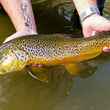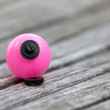Certainly, no one in their right mind would claim the Snake as a “secret water,” but I do believe that most Idaho anglers forsake the Snake when it comes to what I believe to be the most game freshwater fish in America -- even if carp are considered trash fish by most American anglers.
I also hold to the notion that carp are perhaps the ideal freshwater fish for fly rodders -- their general wariness combined with their liberal diet provide challenge and opportunity all at once.
Carp were first introduced into American waters under the U.S. Grant administration -- they were brought in as a source of protein for a developing nation. Since they were first stocked in a pond in Maryland in the 1860s, they’ve spread to every state in the Lower 48 -- and Idaho enjoys a thriving population, particularly in the carp-friendly waters of the Snake River as it flows along the state’s southern third.
I first stumbled upon carp in the Snake in the early 2000s. I’d crossed the dam at American Falls and wandered down a lonely gravel road more often used by farmers and ranchers along the river’s northern banks than by anglers or even hunters who might find deer, moose and pronghorn in this vast desert landscape. I was actually following the directions to a promising place on the river to chase smallmouth bass -- a fish that, at the time, was gaining quite a following in southern Idaho, and one that has since become a treasured fly rod target in its own right on the Snake.
And, while I didn’t find any smallies that day, I was shocked at the numbers of big carp wallowing in two feet of water -- they jumped and tailed and generally worked up a frenzy as they prepared to spawn that glorious May afternoon.
Carp start showing up on the shallow water flats of the Snake in late March, particularly in the river’s downstream reaches near Mountain Home and C.J. Strike Reservoir. By mid-April, a bright, sunny day with temperatures in 70s will bring them up to the flats farther upstream near Raft River and on up to American Falls on the edges of Eastern Idaho.
These natives to Asia will start to spawn in earnest around the first of June and continue for a few weeks, concluding in July. They’ll remain on the flats -- or move back and forth from deeper water to feed -- throughout the summer.
The attraction of carp on the river’s flats -- at least to me -- is they behave like a lot of treasured saltwater fish. They tail and root around for crustaceans, just like redfish. The cruise in hungry pods, just like bonefish. And they can be incredibly selective, like permit. Like all of the above, carp are strong, fast fish prone to reel-whistling runs and shattered graphite.
And, of course, I don’t have to spend a small fortune or two days worth of travel time to get to the places they swim.
No, the backwater flats of the Snake River aren’t the crystalline flats of the Bahamas, but they possess their own beauty, one that’s grown on me over time. The lava bluffs overlooking the green waters of the Snake take my breath away every time I lay eyes on them. And to drive along the river and see these massive invaders -- sometimes pushing 30 pounds -- breaching the frothy surface is a treat only an angler willing to expand his fishy horizons can appreciate.
I remember, as a kid living in suburban Denver, when carp were really the only fish I could dependably catch within range of my banana-seat bicycle or the soles of my sneakers. Using bread dough concocted in my mother’s kitchen, and sunk to the bottom of the lake at Stern Park, carp prodded my imagination and scratched that fish itch until I could find a ride with my grandfather into the Colorado high country to chase brookies and browns and rainbows in cold, clean water of the Rockies.
Today, convincing them to hit a fly is much more challenging than snoozing on the bank and waiting for one to suck in a dough ball past the barbels. And, perish the thought, I honestly believe -- for sheer pleasure -- I’d rather latch into a carp on the flats than I would the average trout.
Blasphemy? For a trout purist, certainly. But for a wandering fly fisher with an itch to experiment, no. That’s not to say there’s no guilt involved. It’s hardly an altruistic endeavor, chasing carp on the fly.
It also doesn’t help, of course, that carp are non-native and generally make a mess of things. Unfortunately, short of a nuclear explosion (and even then, I wonder) in southern Idaho, they’re here to stay. They make up a frightening percentage of the biomass in the Snake and in waters all across America, from the Great Lakes to southern Florida.
I choose to adapt, much as carp have done, to some of the new, alien environments here in Idaho, knowing, of course, that there remain some untouched little gems where things are just as they should be.
Flies
On the Snake, carp enjoy an omnivorous existence. Early in the year, just as they arrive on the flats and start to push into the reeds in search of food, they’re mostly after damselfly and dragonfly nymphs. These bugs swim, and carp chase them. To mimic these large nymphs, I’ve used, with great success, a Stayner Ducktail. The olive body and the mottled ducktail give just right feel to the fly stripped slowly through shallow water. Later, as the water warms, any reasonable imitation of a crawfish will likely work. When sight-fishing for cruising carp with crawfish patterns, cast well ahead of the expected route of the fish and let the fly sink. Only when the fish is a foot or so away from the fly should you give it a twitch.
Streamers, such as Woolly Buggers, leech patterns and sculpin imitations can work as well. When carp are tailing, that’s when they’re the most vulnerable, and thus the most forgiving. Putting flies right on them will work when they’re obviously in a feeding mood.
Gear
Early in the year, you might like a pair of waders, but as spring turns into summer, you’ll be happier wading wet, even on the sometimes creepy mudflats of the Snake. To better your chances and cover more water, consider a one-person pontoon craft that you can control with flippers on your feet. You’ll stir up less water and have more freedom to look for fish.
As for rods, I’d recommend--at a minimum--fishing a 7-weight. The wind across the Snake River Plain is unforgiving, and for that reason, I almost always fish a stout, saltwater-worthy 8-weight with floating line. There are times, when the fish aren’t quite up in the shallows, that a sink-tip or an intermediate sink-tip line would be appropriate, but most carp anglers I know fish with floating line exclusively.
Location
This one’s pretty much up to you -- I’ve caught carp at a number of public access points along the river, ranging from American Falls all the way downstream to Mountain Home. One way to find flats on the river is to cruise its length in the winter, when the Bureau of Reclamation is holding water back in the river’s reservoirs. This lowers the river’s level and you’ll be able to identify flats because they’ll likely be exposed. Roads and access points along the Snake can be found on pages 19, 20, 21, 24, 25, 26 and 29 in the Idaho edition of the DeLorme’s Atlas and Gazetteer.
Editor's Note: The above is an excerpt, from Chris Hunt's latest book, "Fly Fishing Idaho's Secret Waters", a collection of Chris's lifelong efforts to spot burn Idaho's most treasured, hidden rivers and streams.































Comments
PoconoTrout replied on Permalink
Every year I say that this is going to be the year I get my hands dirty with carp, and every year I don't.
I know they're everywhere in eastern PA, and yet I never take a day to try to find them.
This year will be the year,
Pages